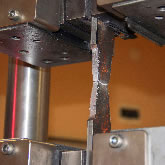 Ed Fagan knows how important the properties of Kovar®, ASTM F15 are to you when evaluating this alloy for an application. As a reference, we have comprised typical key data points to guide customers in their assessment of Kovar®, ASTM F15 Alloy properties. The tables include the mean coefficient of thermal expansion as annealed, physical, mechanical and chemical properties, as well as specifications.
Ed Fagan knows how important the properties of Kovar®, ASTM F15 are to you when evaluating this alloy for an application. As a reference, we have comprised typical key data points to guide customers in their assessment of Kovar®, ASTM F15 Alloy properties. The tables include the mean coefficient of thermal expansion as annealed, physical, mechanical and chemical properties, as well as specifications.
For further information on Kovar® ASTM F15 Alloy, do not hesitate to call us at 800-348-6268. Our professional sales team are experts in the materials we sell and will always assist you in finding a solution to your alloy needs.
To download a copy of the Ed Fagan Kovar® | ASTM F15 Alloy data sheet, or any of our other Controlled Expansion Alloy data sheets, please navigate to the Data Sheets section in our Technical Library.
Remember, no order quantity is too small at Ed Fagan We serve all individuals, markets and industries with our high-quality special metals and alloys.
Mean Coefficient of Thermal Expansion As Annealed |
|||||
|---|---|---|---|---|---|
| Temp Range 77°F to | Coefficient 10-6/°F | Temp Range 25°C to | Coefficient 10-6/°C | ASTM F15 CTE* 30°C to | µm/m • °C |
| 212°F | 3.25 | 100°C | 5.86 | ||
| 392°F | 2.89 | 200°C | 5.20 | ||
| 572°F | 2.85 | 300°C | 5.13 | ||
| 662°F | 2.72 | 350°C | 4.89 | ||
| 752°F | 2.81 | 400°C | 5.06 | 400°C | 4.60 to 5.20* |
| 842°F | 2.92 | 450°C | 5.25 | 450°C | 5.10 to 5.50* |
| 932°F | 3.41 | 500°C | 6.15 | ||
| 1112°F | 4.34 | 600°C | 7.80 | ||
| 1292°F | 5.06 | 700°C | 9.12 | ||
| 1472°F | 5.73 | 800°C | 10.31 | ||
| 1652°F | 6.25 | 900°C | 11.26 | ||
| Average coefficient of expansion properties after annealing in hydrogen for one hour at 1650 °F (900°C) at 15 minutes at 2010° F (1099°C) and cooled to room temperature within one hour. | |||||
| Source: CarTech® Kovar Alloy Data Sheet v. 10/90. *ASTM F15 Table 4 | |||||
To compare the linear coefficient of thermal expansion across our line of controlled expansion glass and sealing alloys, please refer to the Thermal Expansion Table.
ASTM F15 Alloy (Kovar®) Typical Physical Properties |
||
|---|---|---|
| Density | lb/cu in | 0.302 |
| Specific Gravity | 8.36 | |
| Curie Temp | °F | 815 |
| °C | 435 | |
| Melting Point | °F | 2640 |
| °C | 1450 | |
| Electrical Resistivity (70°F) | ohm-cir mil/ft | 294 |
| microhm-cm | 49 | |
| Thermal Conductivity | BTU-in/sq. ft-hr-°F | 120 |
| W/cm °C | 0.17 | |
| Specific Heat | Cal/gm °C | 0.11 |
| BTU/lbm- °F | 0.11 | |
| Source: CarTech® Kovar Alloy Data Sheet v.10/90. | ASTM F15 | ||
ASTM F15 Alloy (Kovar®) Typical Mechanical Properties | ||
|---|---|---|
| *Tensile Strength | ksi (MPa) | 75 (517) |
| **Sheet + Strip, Temper A, Annealed | ksi (MPa) | 82 (570) max |
| **Rod + Wire, Temper A, Annealed | ksi (MPa) | 85 (585) max |
| *Yield Strength | ksi (MPa) | 50 (345) |
| *Elongation | % in 2" | 30 |
| *Typical Hardness (Annealed) | Rockwell B | 68 |
| Modulus of Elasticity | ksi (GPa) | 20,000 (138) |
| Poisson's Ratio | 0.317 | |
| *Kovar strip tested parallel to the direction of rolling. Material annealed 1830 °F (999°C) for 30 minutes, then furnace cooled. ** Per ASTM F15, Temper A, Annealed |
||
| Source: CarTech® Kovar Alloy Data Sheet v.10/90. | ASTM F15 | ||
ASTM F15 (Kovar®) Chemistry | Composition % |
|---|---|
| Iron, nominal | 53.00 |
| Nickel, nominal | 29.00 |
| Cobalt, nominal | 17.00 |
| Manganese, max | 0.50 |
| Silicon, max | 0.20 |
| Carbon, max | 0.04 |
| Copper, max | 0.20 |
| Chromium, max | 0.20 |
| Molybdenum, max | 0.20 |
| Aluminum, max | 0.10 |
| Magnesium, max | 0.10 |
| Zirconium, max | 0.10 |
| Titanium, max | 0.10 |
| The iron, nickel and cobalt % listed are nominal. They shall be adjusted by the manufacturer so that the alloy meets the requirements for coefficient of thermal expansion | |
| The total aluminum, magnesium, zirconium and titanium shall not exceed 0.20% | |
| Source: ASTM F15-04 (2017) Table 1 | |
ASTM F15 (Kovar®) Specifications | |||
|---|---|---|---|
| ASTM F15 | UNS K94610 | AMS 1-23011 CL1 | MIL 1-23011 CL1 |
ASTM F15 (Kovar®) Specifications- Historic Cross- Reference | ||
|---|---|---|
| ASTM F1466 | UNS K94360 | AMS 7726B, 7727, 7728C |
For additional information on specifications of the materials distributed by Ed Fagan, please visit the websites of the international organizations that develop and publish technical standards: ASTM International and ASM International.
Ed Fagan supplies the highest quality special purpose metals and alloys. We stock controlled expansion, refractory, soft magnetic alloys and electronic nickels found in applications for aerospace, aviation, defense, electronics, energy, medical, optical, research and other high-technology industries.
